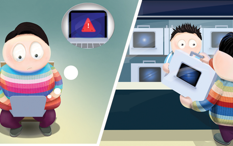What is Incident Management?
An IT Service desk acts as a single point of contact between IT team and end users. Businesses adopt ITIL to improve service efficiency and productivity. ITIL service operation covers Incident management techniques whose primary objective is to ensure smooth business operations with minimal or no downtime.Competent Incident management process bridges the communication gap between end users and IT agents. ITIL Incident management process follows a set of best practices for effective incident handling and incident resolution. Let us look at some of the basics of Incident management.
What is an Incident?
An incident is an unexpected disruption to a service. It disturbs the normal operation thus affecting end user’s productivity. An Incident may be caused due to an asset that is not functioning properly or network failure. Examples of Incidents include printer issue, wifi connectivity issue, application lock issue, email service issue, laptop crash, AD authentication error, file sharing issue etc.
Incident vs service request
Service requests are ‘a formal request from a user for something to be provided – for example, a request for information or advice’. The main difference between Incident and service request is that often pre-approved standard changes are classified as service requests which end users request for. For example, UX designer requests for Adobe photoshop software and increase in RAM space. Having an intuitive service catalog to capture this request is recommended.
Incident vs problem
Problem is a series of incidents with an unknown root cause, whereas incident arises as soon as something breaks or stops working disrupting normal service. Incident handling is usually a reactive process whereas problem management is more proactive. Incident management system aims at restoring services quickly whereas problem management aims at finding a permanent fix.













